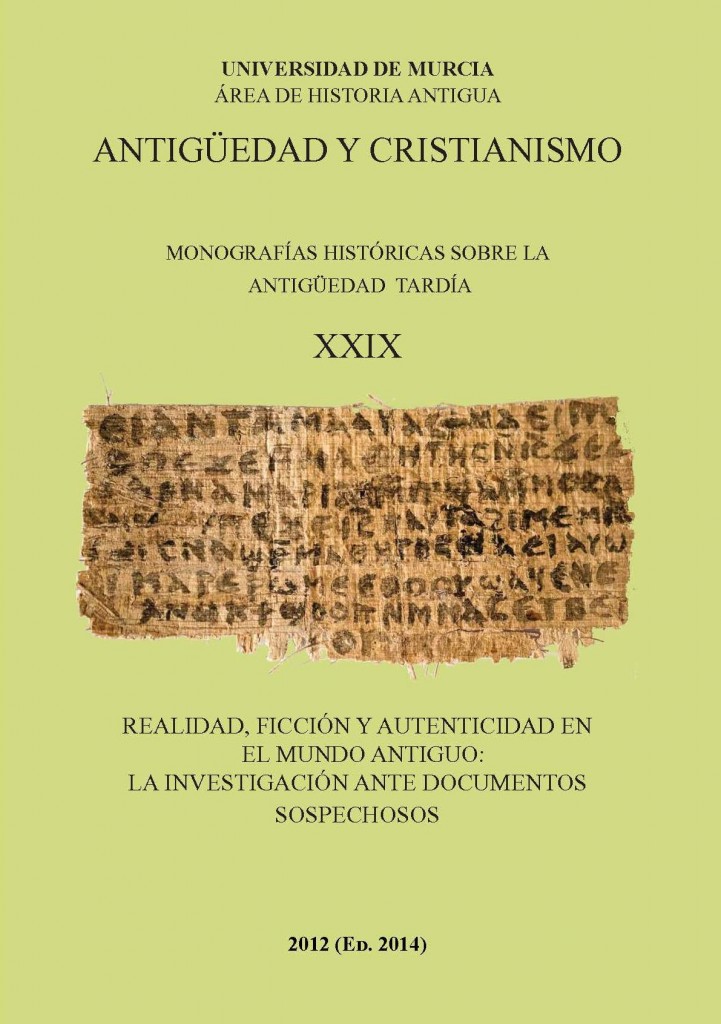Modern Investigation of Suspicious Documents: Issues of Fiction, Forgery and Authenticity
Abstract
One might think that in the 21st century the subject of ancient forgeries and falsifiers would not make headlines in the daily press, yet on April 10, 2014, the New York Times echoed a recent heated academic debate. The news announced "Papyrus referring to Jesus' Wife is more likely ancient than fake, scientists say", i.e. "Papyrus referring to Jesus' wife is more likely ancient than fake, scientists say".1 The papyrus in question was released to the public in 2012 at a conference in Rome, where Karen King of the Harvard Divinity School provocatively named the text fragment - a rectangular piece of papyrus measuring about 4 × 8 cm - as the "Gospel of the Wife of Jesus".
Downloads
-
Abstract229
-
PDF (Español (España))223
References
“Forgery”, en The Classical Tradition, ed. A. GRAFTON / G.W MOST / S. SETTIS, Harvard 2010: 361–364
A. GRAFTON, Forgers and Critics. Creativity and Duplicity in Western Scholarship, Princeton/New Jersey 1990, “Fälschungen”
A. GUZMÁN GUERRA, “Pseudo-literatura, falsifi cación y canon: una perspectiva programática”, en Actas del XI Congreso Español de Estudios Clásicos, ed. A. Alvar, Madrid 2005: 1. 177–216.
B.D. EHRMAN, Lost Christianities: the battles for scripture and the faiths we never knew, Oxford 2005
Der Neue Pauly 4 (1998) 394/97, “Correctores corruptores? Notes on the Social History of Editing”, en Editing Texts-Texte edieren, ed. G.W. MOST, Göttingen 1998 (= Aporemata 2): 54–76
K.K. RUTHVEN, Faking Literature, Cambridge 2001.
M. MÜLKE, Der Autor und sein Text. Die Verfälschung des Originals im Urteil antiker Autoren, Berlin/New York 2008
R.S. LOPEZ, “The Case Is Not Settled”, in The Proceedings of the Vinland Map Conference (PVMC), ed. W.E. WASHBURN, Chicago, 1971
W. SPEYER, Die literarische Fälschung im heidnischen und christlichen Altertum: ein Versuch ihrer Deutung, München 1971
WA39.40.5, cf. Thesaurus proverbiorum medii aevi, Berlin 2002: 13 s.u. Welt, 58.
1. The authors non-exclusively assign the exploitation rights (reproduction, distribution, communication and transformation) to the magazine.
2. The works published in this magazine are subject to the Attribution-ShareAlike 4.0 International license (CC By SA 4.0). Therefore, they can be copied, used, disseminated, transmitted and publicly displayed, provided that:
i) the authorship and the original source of its publication (journal, editorial and URL of the work) are cited, thus allowing its recognition.
ii) it is allowed to remix, transform or create from the material while maintaining the same license as the original.
Note: Articles prior to 2022 incorrectly display the CC by SA license in the abstract page. They are under a CC by NC ND license as embedded in the article pdfs. Articles published in 2022 and after are under the CC by SA license.

3. Self-archiving conditions. Authors are allowed and encouraged to electronically disseminate the pre-print (version before being evaluated) and/or post-print (version evaluated and accepted for publication) versions of their works before publication, as it favors their publication. Earlier circulation and diffusion and with it a possible increase in its citation and reach among the academic community. Color RoMEO: verde.
























